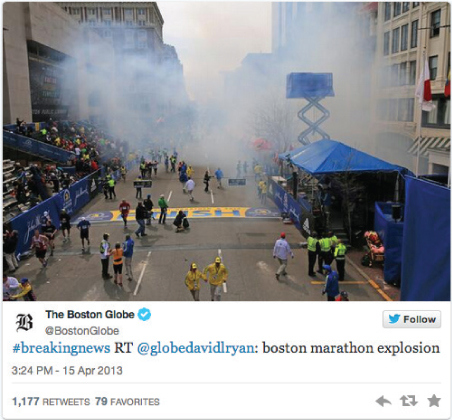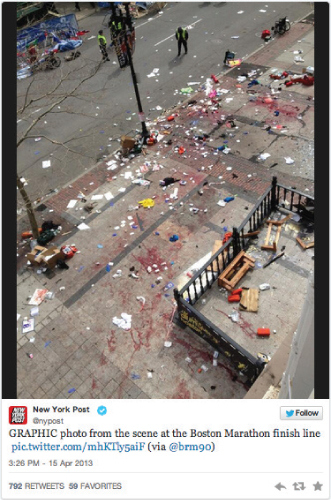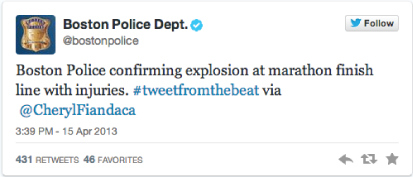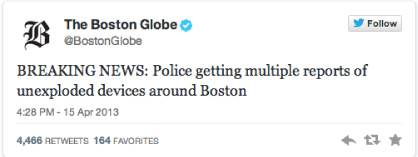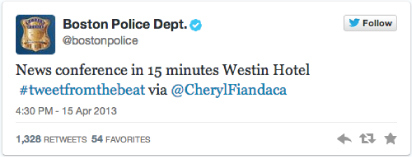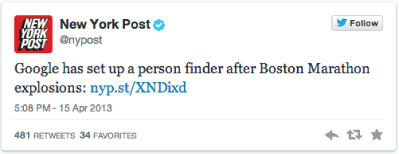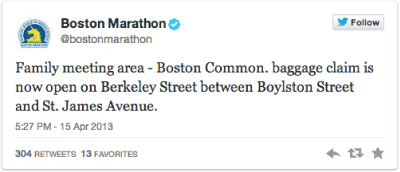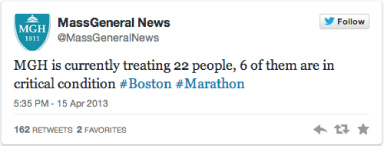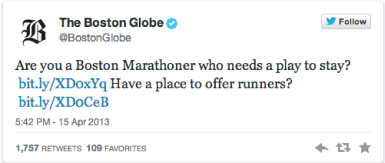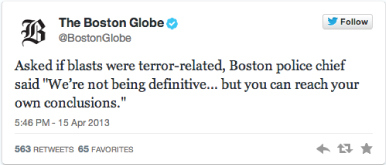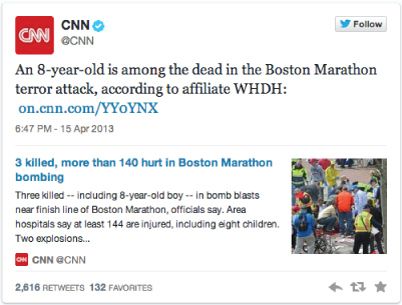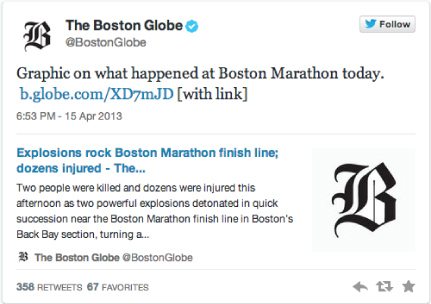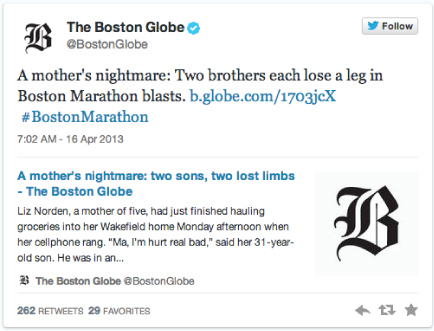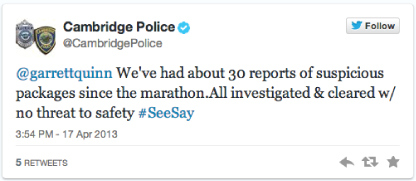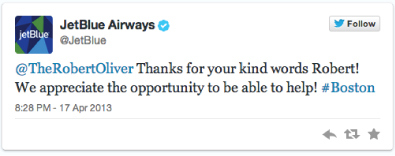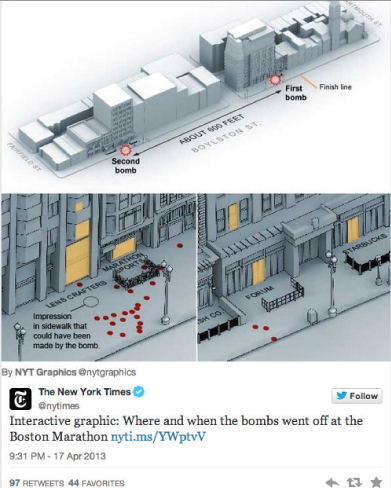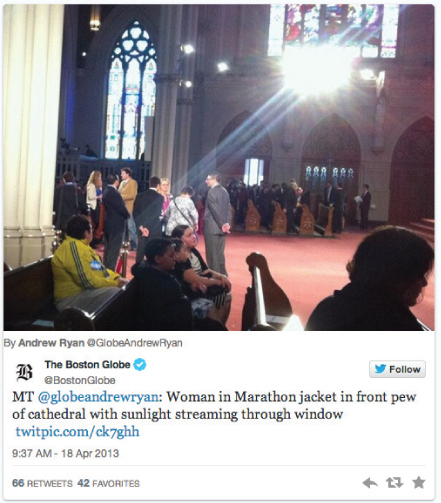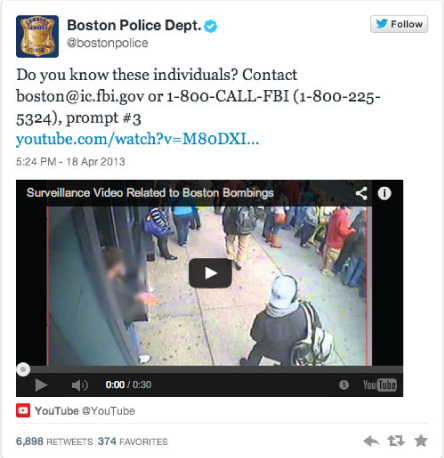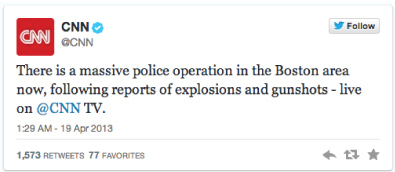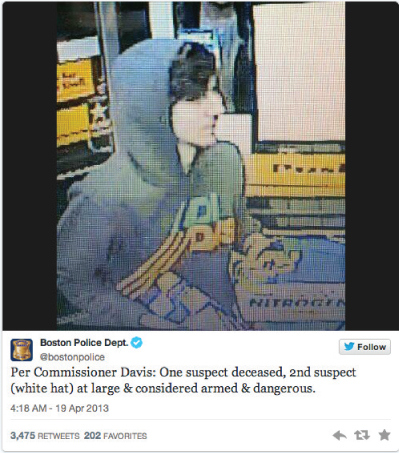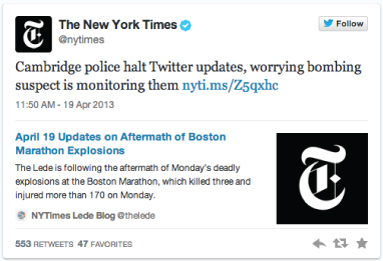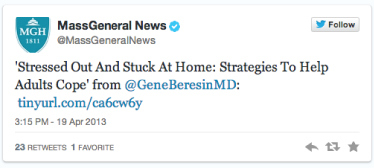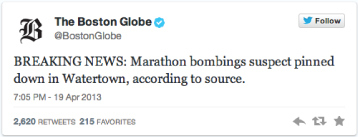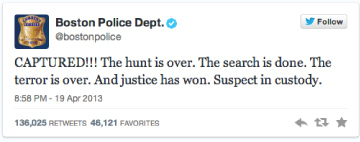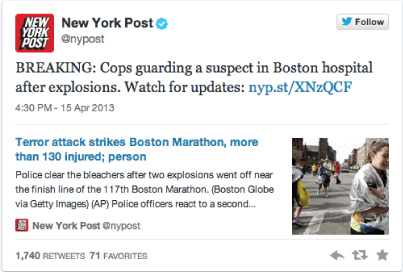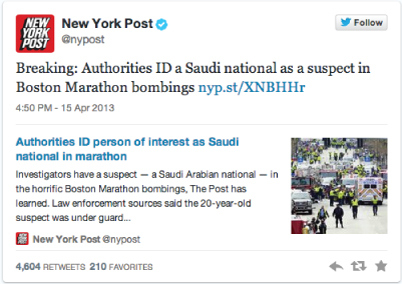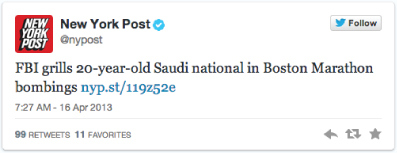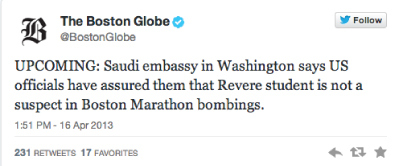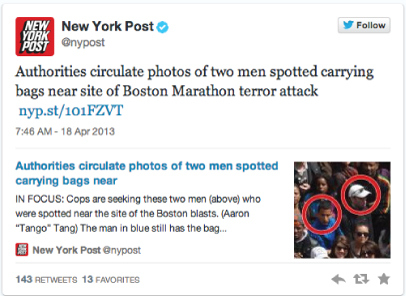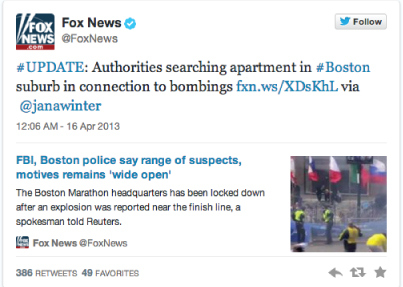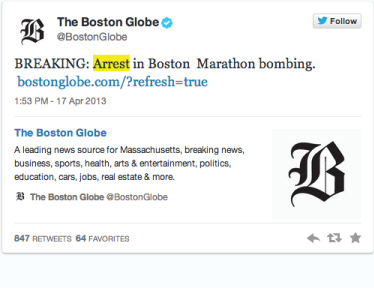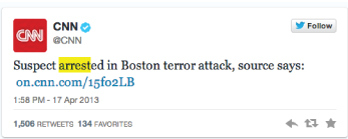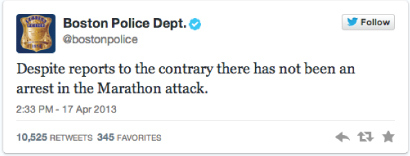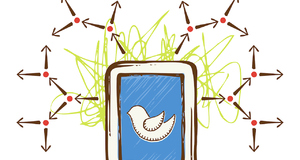From Elon Journal of Undergraduate Research in Communications VOL. 6 NO. 1How Twitter is Changing Narrative Storytelling: A Case Study of the Boston Marathon BombingsIII. MethodsThis case study focuses on the Boston Marathon bombings in 2013, analyzing tweets from 10 Twitter accounts through the frame of social theory, which measures social behaviors and interactions to interpret social phenomena.15 Using some data gathered by Boynton within the hours shortly following the Boston Marathon bombings, the researcher used several of the top retweeted tweets as a basis for understanding the climate of the narrative. The researcher then created a narrative of the tweets from ten sources, which are as follows:
These Twitter users were chosen based on their importance as a source of information from a public interest standpoint (Boston and Cambridge Police, Mass General Hospital), their role as a news organization trying – and sometimes failing – to communicate information swiftly and accurately (Boston Globe, CNN, New York Post, Fox News, The New York Times), their position as a corporate sponsor of the marathon itself in an attempt to gauge the behavior of a corporation in a crisis situation (JetBlue) and, finally, their function as the official Twitter source of information on the marathon (Boston Marathon). JetBlue was chosen in particular because it tweeted more than any other corporate sponsor with an active Twitter account during the five-day time period in this study. These sources are meant to give a variety of perspectives on the issues at hand. These sources’ tweets were collected in a Storify collection and were then analyzed as a whole, showing a full picture of the bombings and the subsequent manhunt. The tweets span from April 15, 2013, one hour before the bombs went off at 2:49 p.m. EDT, to the end of the manhunt for the Tsarnaev brothers on April 19. Tweets inserted into the narrative include all tweets by these sources during that timeframe that use any of the following words: “Boston,” “marathon,” “bombing,” “attack,” and “manhunt,” unless noted differently above. One tweet was included that is not from the sources on this list. PzFeed Top News (@PzFeed) tweeted during this period: “POLICE AND FBI URGING ANYONE WITH VIDEO OF THE FINISH LINE AT THE TIME OF THE EXPLOSION SHOULD PLEASE COME FORWARD.” This was the most retweeted tweet in Boynton’s data with 10,275 retweets in the hours following the bombings.16 PzFeed’s tweet only has 142 RTs, making it likely that this account is not the original source of this tweet, a variable that was not included in Boynton’s data. However, it is also the only tweet that is found in Twitter’s search that matches this phrase. Because of the enormous influx of people in a small geographic area in this situation, the livetweeting of this event is different from many other disasters because people in a natural disaster or a more widespread attack would be more evenly dispersed throughout different areas. The sheer number of people at the finish line made the tweets about this attack different than other similar attacks because of the size of the crowd and its central location. A case study like this one is important to the understanding of interactions on social media, particularly Twitter, in crisis situations. While many studies have been done on crisis reporting and media coverage, few have been recent enough to explore social media’s impact on a particular crisis as pressing and timely as the Boston bombings. IV. FindingsThis is a summary of the hundreds of tweets from the ten sources listed in the methods section. It is broken down by timeframe across the days of the attack and subsequent manhunt, with one exception: inaccurate news reports were categorized separately because of their prevalence in this case. Before the attack: An ordinary live-tweeting scenarioMany sources were tweeting Boston Marathon-related tweets during the hours prior, ranging from The Boston Globe detailing why one columnist never wants to run a marathon again to a listing of top performers from past marathons. The above tweet from Massachusetts General Hospital shows the enthusiasm of the many live-tweeters at the marathon before the tragedy occurred at 2:49 p.m. April 15.
Real time of the attackAt 2:57 p.m., the first report from the ten sources listed came in regarding the bombings via The Boston Globe. Two minutes later, they fully broke the news.
News teams mobilized immediately, many citing the Globe or confirming their information with sources, like Fox News, which confirmed information with a Boston Marathon spokesman.
Fox News was also the first of these sources to tweet a link to its coverage. CNN tweeted that it had a producer on the scene and that there was live video on TV.
The Boston Globe tweeted the first picture among the ten sources.
Following The Globe’s tweet, the New York Post tweeted a much more graphic image of the aftermath.
The Boston PD tweeted its first official confirmation 50 minutes after the bombing occurred. The Boston Marathon tweeted its first confirmation shortly after. Many sources began tweeting the number of injured people reported. The figures were wide ranging, estimating 19 to 28 injured and two or three individuals dead. In the end, a total of three people were killed and 264 individuals were injured.17
The Boston Globe’s interaction with the Boston Police on a direct level was apparent from its Twitter feed. Most of their tweets were confirmed with the police.
Boston Police publicized a press conference fairly quickly via Twitter. They then asked for tips, photos and video via Twitter to help the investigation. The Cambridge Police even joined in, telling people to contact the Boston PD with information. The BPD also asked people not to congregate in large crowds following the bombings.
Google’s person finder was an important resource because The Boston Globe had just retweeted AP’s story on the shutting down of cell phone use in Boston to prevent the detonation of more explosives. Many sources tweeted about the topic throughout the day, publicizing it for those who struggled to reach loved ones.
The Boston Marathon’s tweets were mostly perfunctory. The source tweeted sparsely – only when information was pressing and immediately useful to people.
MGH (Mass General Hospital) took on a similar role as a perfunctory tweeter — tweeting only when necessary to inform the public of the goings-on.
Despite its occasional misspellings (“play to stay”), the Globe also became a valuable resource for marathoners, by providing more than just information for those who wanted it. The source gave actionable information that allowed people to function more normally in a time that was distinctly not normal. CNN and Fox News soon reported that Obama would make a statement at 6:10 p.m. ET.
Posts in real time: Sources begin to review the aftermathThis tweet was the first of its kind during the post-bombing time period: It was a quote, and this comment told a story. This led to many sources beginning to do more in-depth reporting on the disaster. The Marathon’s official Twitter account continued providing perfunctory information like where people could catch buses. When President Obama’s speech began, many sources tweeted phrases and sentences from his speech. Others started to post stories about individuals who died.
CNN was the first to tweet that one of the victims of the bombing was an 8-yearold child. This story gained further attention as the days continued. The Boston Globe tweeted a graphic of the marathon’s explosions and was the first to tweet edited visuals that were not immediately distributed on the scene, like many of the photographs and videos tweeted earlier on the site. The edited visuals beyond the on-site media showed the news source’s judgment in the post real-time period. It became clear to many — both because the site provided refined tweets like this and it also took down its paywall to provide even non-subscribers with information — that the Globe’s newsroom was intently focused on delivering as much accurate news as possible to those who needed it. Links to more narrative stories began to be tweeted around 7 p.m., with witness reports from The New York Times and photos from The Boston Globe. The tweet below is reminiscent of another narrative-type story that came out the following morning.
In the day after the attack, columns started pouring in; photos appeared from other newspapers that had paid tribute to the fallen city; and news sources tweeted photos of the home of Martin Richard, the 8-year-old boy who died in the explosion.
The Cambridge Police used their presence to keep people posted about suspicious reports and to remind the public if they saw something, to alter the proper authorities.
JetBlue continued to provide words of encouragement to the community as a sponsor of the marathon. This tweet was in response to a tweet from Robert Oliver, who said, “Thanks for being the best airline out there, standing with #Boston every step of the way. #TrueBlue,” and it was one of several tweets from people who thanked JetBlue for the company’s services.
The New York Times, after having more time to get teams together to create new visuals, started publishing interactive graphics, much like The Boston Globe’s.
Throughout the tragedy, news sources on the ground attempted to shine a small light of hope to help raise the spirits of people in the area. The image above is just one of these images. A press conference took place with Boston Mayor Thomas Menino and President Obama in the cathedral a few hours later.
The Manhunt: Sources respond to a second breaking news eventLater that day, the Boston Police posted images of the suspects, asking the public to send tips to a hotline.
In the middle of the night on April 19, CNN posted that the Boston Police were taking part in an investigation, which the department confirmed via Twitter less than an hour later. The police department tweeted important information, including news on where the press should set up not to hamper the investigation, information on staying indoors in the Watertown area where the manhunt was taking place, and a photo of Dzhokhar Tsarnaev, the suspect on the run in the manhunt.
The department tweeted the photo out several times throughout the night, but few other news sources tweeted during those hours, except to state the same information: one suspect was dead and the other was armed, dangerous and still at large. The Boston Globe tweeted school and public transportation closures in the early morning. Hospitals were also on lockdown, according to The Globe. Information about the suspects was tweeted throughout the day, including license plates of a possible car that Tsarnaev was driving. Even obscure information, like the fact that the suspects “followed [a] Harry Potter-hating Australian sheikh,” was tweeted by sources like Fox News. An interesting development occurred when the Cambridge Police stopped tweeting because they didn’t want the suspect to receive live-updates about what was happening. This was particularly attention-grabbing because, while it stopped some of the narrative storytelling, it showed how aware sources were that the new storytelling form was accessible to anyone, even the suspect authorities were trying to capture. Sources that did not traditionally cover news provided relevant links for people seeking some sort of solace on Twitter. Mass General’s tweets about coping with being stuck inside because of the bombings belong to one such form of non-traditional, but relevant, news. At 7:05 p.m. on April 19, the first report that the suspect was captured was released on Twitter. The Boston Police later followed this message up to verify and also sent out this tweet. All these tweets combined to create a narrative of the Boston Marathon bombings and subsequent manhunt for the suspects who caused the tragedy. Twitter was an important tool for communicating information to the public. Inaccurate news reportsThis tweet by the New York Post was the first of many inaccurate posts by news media striving to be first to report news. The Post soon reported that the Boston PD confirmed another explosion at JFK Library. The police had not confirmed this information, and the “explosion” was actually a fire that was unrelated to the bombings. At 4:50 p.m., the New York Post tweeted the following message. This tweet was not accurate, nor was a fair amount of information in the link that was tweeted, including “A law enforcement source confirmed to the Post that 12 people were killed and nearly 50 were injured in today’s blast,” when only three died. The information tweeted about the Saudi national was false and caused a great amount of backlash from people who believed the inaccurate report to be an instance of racial profiling. Tweets like the New York Post’s serve as a strong reminder that if information is inaccurate, it can make a news source look untrustworthy and inept in the long run. These tweets themselves were not always inaccurate, but they were leading, and they made it easy to point the finger at an oppressed group in American society. The Boston Globe debunked the Post’s reporting later that same day. CNN also stated later, “Investigators have found no foreign or al Qaeda connection to the bombings, U.S. official tells CNN . . .” The Post is still shrouded in controversy over a non-Twitter transgression. Two men were photographed on the newspaper’s cover with the words “Bag Men,” which suggested that they were involved with planting the bombs. The men in the photo below were not suspects and had not been arrested or charged with a crime. They were simply identified by police as persons of interest. The men had willingly gone to police on April 17, the day before this tweet, to explain their whereabouts and tell police that they were not involved. Media Matters for America and New York Daily News reported in early October that the Post settled its lawsuit with the two men. Information from these sources said that “neither side would disclose terms of the settlement.”18 Fox News’ tweet about an apartment search in relation to the bombings did not lead to any arrests, but it goes to show how intensely and aggressively the media was covering every possible lead that could provide them a story. CNN’s tweet about “five viral stories about the Boston terror attacks that aren’t true” was a precursor to a tweet by CNN that was, in fact, a viral story that wasn’t true. CNN and The Boston Globe both tweeted that a suspect was taken into custody on April 17. After many news sources retweeted this, it was found incorrect when the Boston PD tweeted that no such suspect had been found. The courthouse where the suspect was to be detained was evacuated shortly after due to reports of a possible bomb threat. A man had left gas cans in his car, which led to suspicion. An FBI briefing scheduled for that evening at the courthouse was then canceled, due to the supposed bomb threat. These were just a few of many inaccuracies throughout the coverage of the bombings. Eventually, the media reported matters correctly as the suspects were killed and captured, but many sources misreported news throughout the bombings. A full compilation of the tweets in narrative form is available at https://storify.com/marykatebrogan/boston-marathon-bombings.Continued on Next Page » Suggested Reading from Inquiries Journal
Inquiries Journal provides undergraduate and graduate students around the world a platform for the wide dissemination of academic work over a range of core disciplines. Representing the work of students from hundreds of institutions around the globe, Inquiries Journal's large database of academic articles is completely free. Learn more | Blog | Submit Latest in Business & Communications |





